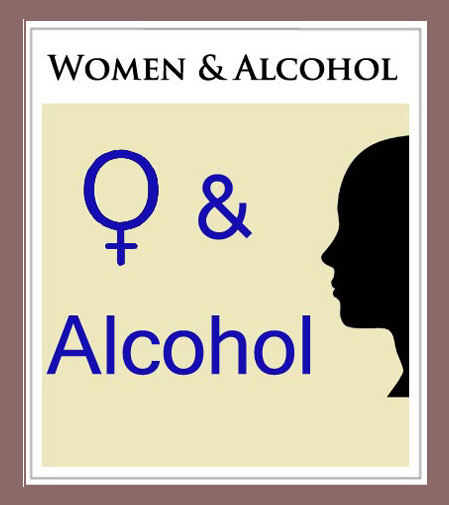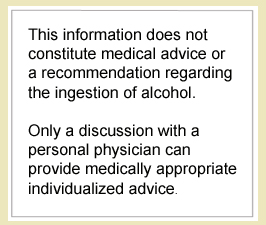Women and Alcohol

Women & Alcohol pdf file
Special Considerations
E.Roehm, M.D.
Introduction
The effect of alcohol in women differs from men in two major ways. The first difference is the obvious one, “less is more”. Lower levels of alcohol ingestion in women result in higher alcohol blood levels. A woman’s lower volume of distribution of alcohol, as well as decrease in the activity of the enzyme which degrades alcohol (alcohol dehydrogenase) are reasons for the higher blood levels of alcohol.1,2

The second major difference between men and women in the effects of alcohol consumption is that breast cancer is significantly increased with alcohol intake in women.3 Even moderate levels of alcohol intake increase the risk of breast cancer.
On the other hand, moderate levels of alcohol intake in women are associated with a decrease in total death rate, heart attacks, and strokes in women in observational studies.4-7 With higher intakes of alcohol though, the overall benefit disappears and becomes replaced by an overall risk.
A frequently heard recommendation that alcohol intake be limited to less than or equal to one alcoholic beverage per day if a woman drinks alcohol is well grounded in science. The net potential benefit present with one drink per day quickly disappears as the amount of alcohol increases.5
The effect on total death rate represents, in a sense, a summation of the positive and negative aspects of alcohol ingestion. In women, the total death rate is reduced at one drink a day, but shows an increase in the death rate at two drinks a day5 (when a drink is defined as 14 grams of alcohol). And, similar to men, there are many women who should never drink alcohol, including those with liver disease, GI bleeding, history of alcoholism, and certain types of heart disease, to name a few.
The following information takes a closer look at alcohol intake and women in regards to survival, breast cancer, other types of cancer, stroke, and heart attack. The studies that this information comes from are observational studies rather than randomized trials, so the relation of alcohol to these findings is not necessarily one of cause and effect, but rather an association.
What constitutes one alcoholic beverage (or one drink) in the scientific literature?
There are a variety of definitions in the literature but one alcoholic beverage is often defined as 5 ounces of wine, a 12 oz can or bottle of beer, or 1.5 ounces of 80 proof distilled spirits. These 3 beverages in these quantities have similar amounts of alcohol present.
Alcohol and Total Mortality
Moderate levels of alcohol intake ( ½ -1 alcoholic beverage per day) are associated with an approximate 10 to 15% reduction in total mortality (all causes of death including heart attack, stroke, and cancer) in middle aged and older women.5 However, as the average alcohol intake escalates beyond this level, this improvement in mortality disappears and an increased risk of death develops.
Women & Alcohol Ingestion- Effect on Total Mortality5 in middle aged and older women
| Alcohol Intake (daily average) | Change in death rate |
|---|---|
| ~ 1/4-1 drink/day (1-7 drinks/week) | ~ 10-15% reduction in mortality |
| ~ 1 3/4 drinks/day (12 drinks/week) | no effect |
| 2 drinks/day (14 drinks/week) | ~ 3% increase in mortality |
| 3 drinks/day (21 drinks/week) | ~ 20% increase in mortality |
| >3 drinks/day (>21 drinks/week) | further significant increases |
(A drink in this chart is defined as 14g of alcohol/drink)
As seen in the table above, when alcohol intake increases to an approximate average of 13/4 drink/day there is no associated benefit or risk in total mortality.5 However, by the time alcoholic intake increases to an average alcoholic intake of 2 drinks/day, the overall risk of death (total mortality) increases to 3% higher than a non drinker. By an average of 3 drinks/day (21 drinks/week), there is an increase in total death rate of approximately 20%. Higher average intakes are associated with even greater increases in total death rate.
(Men, in contrast, show a benefit in total mortality for both an alcohol intake of one and two drinks daily. At an average intake of 3 drinks daily, there is no longer a benefit of alcohol ingestion for men and intake above 21 drinks/week results in a progressive worsening of the overall death rate.5)
A question may come to mind: can alcohol intake routinely be significantly higher on some days and just averaged out by not drinking on other days? No, this is not the case for significantly higher episodic alcohol intake. It is not healthy to excessively drink on one day and then not drink another day hoping that the effects will average out. Binge drinking in particular, is associated with higher risk.8
In summary, moderate levels of alcohol intake in women (less than or equal to 1 drink /day) are associated with a decreased risk of death. As alcohol intake increases, there develops an increased risk of death. The window of benefit is narrow and restricted to modest levels of ingestion. Also, given that data for both benefit and risk with alcohol does not come from randomized trial but rather from observational studies, the relationships are not proven to be the result of cause and effect.
Younger women, special considerations:
Consider a woman 35 years of age who is premenopausal.
This woman would have little potential for benefit from low level ingestion of alcohol, but would retain the risks of alcohol ingestion. Alcohol at low levels of ingestion is associated with decreased risk of cardiovascular diseases which younger women develop relatively infrequently. Also, a significant portion of the potentially beneficial effect of alcohol is the result of an increase in good cholesterol (HDL cholesterol) that occurs with alcohol ingestion.9,10 Since premenopausal women already tend to have high HDL levels, alcohol can do little to improve upon this baseline level. Even low levels of alcohol ingestion are associated with an increased risk of breast cancer. See below:
Breast Cancer
Alcohol intake increases breast cancer.3,11,12 Even at moderate levels of alcohol intake, the risk of breast cancer is higher. A study published in 2009 followed over a million middle aged women with a mean age of 56 for approximately 7 years.12 The results of this study were similar to previous studies, but because of the size of the study there was additional reliability of the results in regards to breast cancer and alcohol.
The following table provides information on the relationship of the risk of developing breast cancer and alcohol. (The table is derived from references 12 & 13.)
Increased Breast Cancer Risk with Alcohol Ingestion
| Alcohol Intake | Increase in Breast Cancer Risk | Additional Cases of Breast Cancer (during the lifetime of the woman resulting from alcohol) |
|---|---|---|
| 3- 6 drinks/ week | 8% | ~ one additional woman out of 100 will be diagnosed with breast cancer |
| 7-14 drinks/ week | 13% | ~ 2 (1.6) additional women out of 100 will be diagnosed with breast cancer |
| >15 drinks/ week | 29% | ~ 3-4 additional women out of 100 will be diagnosed with breast cancer |
Women who drank an average of 3-6 drinks per week had an 8% increase in the risk of breast cancer and a 13% increase in breast cancer risk with 7-14 drinks per week.12 For greater or equal to 15 drinks/ week, the risk increased by 29%. There were very few participants who drank more than an average of 21 drinks/ week, but it would be anticipated from other studies that these women would be at a higher risk proportional to the amount of additional alcohol they drank.
The lifetime risk of a woman being diagnosed with breast cancer risk is 12.2% or a risk of about 1 in 8.13 For a woman drinking 3-6 drinks per week, the chance of breast cancer being diagnosed is 8% higher than otherwise would be the case.12
If one makes the assumption that the risk with alcohol found in these studies persists in a similar fashion for the lifetime of the individual, this means that one additional woman out of every 100 women (.08 x .122≈ 1%) will be diagnosed with breast cancer because of alcohol. There was no difference in the effect of red wine vs. other sources of alcohol in regards to breast cancer incidence.12
What about other cancers?
Certain types of cancer have been linked to alcohol intake through multiple studies, including liver, stomach, and esophageal cancers. The risk goes up as the amount of alcohol consumed increases. There are other types of cancer that are less frequent with alcohol ingestion (kidney cancer, thyroid cancer, and a type of lymphoma).14-17
The Million Women Study, by virtue of its large size, allowed multiple different cancers to be evaluated. 12 With high levels of alcohol intake, there was a net increase in cancer from sites other than the breast. However, for levels of alcohol intake less than or equal to 14 drinks per week, the net increase in the total cancer rate was entirely the result of the increase in breast cancer. The effects of alcohol for this level of drinking for the other types of cancer were counterbalanced (details). The increase in the diagnosis of oral cavity cancers, esophageal cancers and liver cancer were balanced out by the decrease in kidney cancer, non-Hodgkin lymphoma, thyroid cancer, and other types of cancers.
However, when alcohol intake goes beyond 14 drinks per week, breast cancer as well as net cancer diagnoses other than breast cancer are both higher for those drinking alcohol.
Stroke
Stroke in women is a common disease, particularly as age progresses. Moderate levels of alcohol ingestion are associated with a significant reduction in overall stroke rate, but high levels of alcohol ingestion correlate with a greater frequency of stroke.4
Since 1 out of 5 women have a stroke sometime during their lifetime, a reduction in frequency of stroke rate is potentially important.18 With an alcohol intake of less than or equal to 1 drink daily (≤7 drinks/week) there is an approximate 20% lower rate of stroke occurrence.4 When alcohol increases to 3 drinks/daily, the overall incidence of stroke rate is no longer improved with alcohol ingestion. 4 Subsequent higher alcohol intakes are associated with higher overall stroke rates.
There are two types of stroke. The most common type is an ischemic stroke (caused by a blood vessel closing off) and the less common stroke is a hemorrhagic stroke (caused by bleeding).18 One study looking at these types of stroke found a lower rate of both types of stroke and a lower rate of stroke mortality for ischemic stroke with an alcohol intake of one drink per day.19 As drinking intake increased, there was a marked increased in stroke occurrence and mortality.
Alcohol ingestion in women participating in longitudinal studies shows an overall beneficial effect on stroke frequency and mortality20, but this can not be generalized beyond the relatively modest average alcohol intake seen in these studies. The overall improvement is most likely on the basis of the greater frequency18 of ischemic stroke which is favorably affected by alcohol rather than the less frequent hemorrhagic stroke which can be adversely affected by alcohol.7
In summary, moderate levels of alcohol ingestion (average intake of less than or equal to one drink daily) are associated with a significant reduction in the overall occurrence of stroke.4 As levels of alcohol ingestion increase, the benefit is no longer seen and for higher levels of alcohol ingestion, the overall stroke rate and mortality is increased.
Heart Attack
Alcohol ingestion decreases the risk of heart attack and death from heart attack.7,20 There is a lower risk of heart attack and death from heart attack at low and moderate levels of alcohol ingestion. At greater than or equal to 3 drinks daily, an increase in coronary heart disease mortality has been found.21
Weight gain or loss
Alcohol is a significant source of calories (7 calories per gram). Adding calories from alcohol without subtracting them from other sources will result in weight gain.
However, in the Women’s Health Study, 19,000 middle aged and older women were followed for an average of 13 years.22 There was an inverse association between weight gain and alcohol intake. The women who had a light to moderate alcohol intake gained less weight and were less likely to become obese. Whether this was the result of factors associated with alcohol ingestion rather than the alcohol itself is not known.
Summary
Women have special issues regarding alcohol and health. There is an increase in breast cancer at all levels of alcohol ingestion.3 Nevertheless, at moderate levels of alcohol ingestion (less than or equal to one drink a day) in middle aged and older women, there is a decrease in total death rate, strokes, and heart attacks.4,5,20 As levels of alcohol intake increase, there is an increased risk of death, stroke, cardiac mortality, and breast cancer. In part due to the magnified effects of any given dose of alcohol in women, there is a relatively narrow window of potential benefit and broader range of intakes with a net negative effect.
References:
1. Frezza M, di Padova C, Pozzato G, et al. High blood alcohol levels in women. The role of decreased gastric alcohol dehydrogenase activity and first-pass metabolism. N Engl J Med. 1990:322:95-9.
2. Ely M, Hardy R, Longford NT, Wadsworth ME. Gender differences in the relationship between alcohol consumption and drink problems are largely accounted for by body water. Alcohol Alcohol. 1999;34:894-902.
3. Smith-Warner SA, Spiegelman D, Yaun SS, et al. Alcohol and breast cancer in women: a pooled analysis of cohort studies. JAMA. 1998;279:535-40.
4. Reynolds K, Lewis B, Nolen JD, Kinney GL, Sathya B, He J. Alcohol consumption and risk of stroke: a meta-analysis. JAMA. 2003;289:579-88
5. Di Castelnuovo A, Costanzo S, Bagnardi V, Donati MB, Iacoviello L, de Gaetano G. Alcohol dosing and total mortality in men and women: an updated meta-analysis of 34 prospective studies. Arch Intern Med. 2006;166:2437-45.
6. Fuchs CS, Stampfer MJ, Colditz GA, et al. Alcohol consumption and mortality among women. N Engl J Med. 1995;332:1245-50.
7. Stampfer MJ, Colditz GA, Willett WC, Speizer FE, Hennekens CH. A prospective study of moderate alcohol consumption and the risk of coronary disease and stroke in women. N Engl J Med. 1988;319:267-73.
8. Mukamal KJ, Maclure M, Muller JE, Mittleman MA. Binge drinking and mortality after acute myocardial infarction. Circulation. 2005;112:3839-45.
9. Gaziano JM, Buring JE, Breslow JL, et al. Moderate alcohol intake, increased levels of high-density lipoprotein and its subfractions, and decreased risk of myocardial infarction. N Engl J Med. 1993;329:1829-34.
10. Schäfer C, Parlesak A, Eckoldt J, et al. Beyond HDL-cholesterol increase: phospholipid enrichment and shift from HDL3 to HDL2 in alcohol consumers. J Lipid Res. 2007;48:1550-8.
11. Zhang SM, Lee IM, Manson JE, et al. Alcohol consumption and breast cancer risk in the Women’s Health Study. Am J Epidemiol. 2007;165:667-76.
12. Allen NE, Beral V, Casabonne D, Kan SW, Reeves GK, Brown A, Green J; Million Women Study Collaborators. Moderate alcohol intake and cancer incidence in women. J Natl Cancer Inst. 2009;101:296-305.
13. National Cancer Institute. Probability of Breast Cancer in American Women. http://www.cancer.gov/cancertopics/factsheet/detection/probability-breast-cancer Accessed 03/2011
14. Lee JE, Hunter DJ, Spiegelman D, et al. Alcohol intake and renal cell cancer in a pooled analysis of 12 prospective studies. J Natl Cancer Inst. 2007;99:801-10.
15. Nagano J, Mabuchi K, Yoshimoto Y, et al. A case-control study in Hiroshima and Nagasaki examining non-radiation risk factors for thyroid cancer. J Epidemiol. 2007;17:76-85.
16. Rossing MA, Cushing KL, Voigt LF, et al. Risk of papillary thyroid cancer in women in relation to smoking and alcohol consumption. Epidemiology. 2000;11:49-54.
17. Morton, LM, Zheng T, Holford TR, et al. Alcohol consumption and risk of non-Hodgkin lymphoma: a pooled analysis. Lancet Oncol. 2005;6:469-76.
18.Seshadri S, Beiser A, Kelly-Hayes M, Kase CS, et al. The lifetime risk of stroke: estimates from the Framingham Study. Stroke. 2006;37:345-50.
19. Additional downloadable file 3; Patra J, Taylor B, Irving H, et al. Alcohol consumption and the risk of morbidity and mortality for different stroke types–a systematic review and meta-analysis. BMC Public Health. 2010;10:258.
20. Ronksley PE, Brien SE, Turner BJ, Mukamal KJ, Ghali WA. Association of alcohol consumption with selected cardiovascular disease outcomes: a systematic review and meta-analysis. BMJ. 2011,342:d671. doi: 10.1136/bmj.d671.
21. Ikehara S, Iso H, Toyoshima H, et al.; Japan Collaborative Cohort Study Group. Alcohol consumption and mortality from stroke and coronary heart disease among Japanese men and women: the Japan collaborative cohort study. Stroke. 2008;39:2936-42.
22. Wang L, Lee IM, Manson JE, Buring JE, Sesso HD. Alcohol consumption, weight gain, and risk of becoming overweight in middle-aged and older women. Arch Intern Med. 2010;17:453-61.
